- Quick Read
- Deep Read ( 5 Min. )
Monitor Daily Podcast
- Follow us:
- Apple Podcasts
- Spotify
- RSS Feed
- Download
TODAY’S INTRO
Monitor stocking stuffers
 Mark Sappenfield
Mark Sappenfield
Thanks for ending your week – and your year – with us. The Monitor will be on holiday recess through Jan. 1, but we’ll be keeping in touch and stoking the hearth fire for you.
We’ll highlight our wonderful new holiday animation on Christmas Day. That’s a gift from essayist Murr Brewster and Jules Struck that’s become an annual tradition. After that, watch for daily specials that feature some of our best stories of 2023, grouped around themes including community and peace. Finally, on New Year’s Day, we’ll send you our favorite photos of 2023 collection, curated with care and love.
See you in 2024!
Share this article
Link copied.

Help fund Monitor journalism for $11/ month
Already a subscriber? Login

Monitor journalism changes lives because we open that too-small box that most people think they live in. We believe news can and should expand a sense of identity and possibility beyond narrow conventional expectations.
Our work isn't possible without your support.
Texas tries a DIY border fix. Is that legal?
Amid concerns about record encounters with migrants at the southern U.S. border, one of the most affected states is trying to take action on its own. But is that legal?
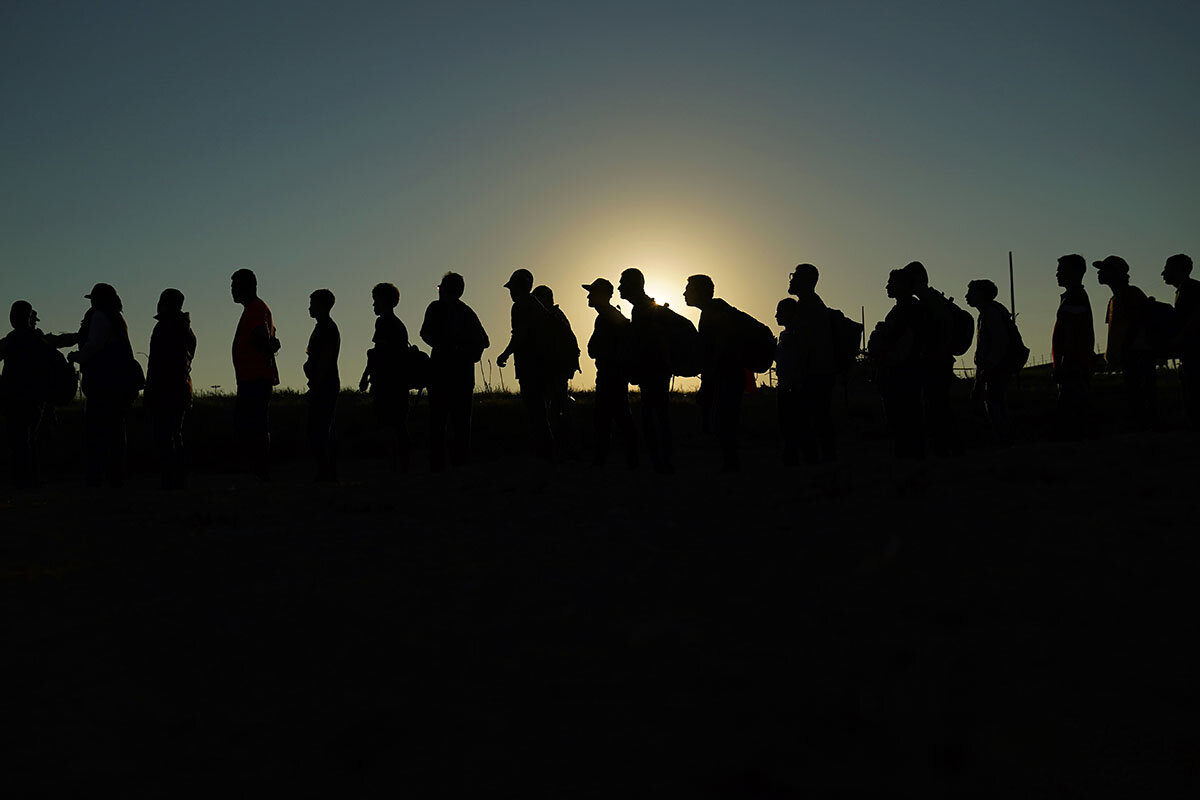
Texas moved this week to give state officials unprecedented immigration powers, setting up a clash with the federal government's constitutional duty to oversee the issue.
A key impetus: Record numbers of migrants have arrived at the southwest border in recent years. Lately, more than 2 million per year have been crossing illegally, often to request asylum, and are landing in a judicial system not equipped to handle the flow.
On Monday, Gov. Greg Abbott signed a law that will allow state police to arrest immigrants for entering Texas illegally. State judges can punish offenders with fines and jail time, and send them back to Mexico. The law, which is scheduled to go into effect in March, has already drawn a legal challenge.
The law is part of broader moves by Texas that may increasingly amount to a de facto immigration system. Civil rights groups say the efforts for almost three years have been rife with due process violations and discrimination. State officials say Texas is reinforcing its stretch of the border in the absence of a meaningful federal response.
The new law “goes further than any [other] state-level attempt at getting involved in immigration,” says Denise Gilman, co-director of the Immigration Clinic at the University of Texas School of Law.
Texas tries a DIY border fix. Is that legal?
Texas moved this week to give state officials unprecedented immigration powers, setting up a clash with the federal government’s constitutional duty to oversee the issue.
A key impetus: Record numbers of migrants have arrived at the southwest border in recent years. Lately, more than 2 million per year have been crossing illegally, often to request asylum, and landing in a judicial system not equipped to handle the flow.
On Monday, Gov. Greg Abbott signed a law that will allow state police to arrest immigrants for entering Texas illegally. State judges can punish offenders with fines and jail time, and send them back to Mexico. The law, which is scheduled to go into effect in March, has already drawn a legal challenge.
The law is part of broader moves by Texas that may increasingly amount to a de facto immigration system. Civil rights groups say the efforts for almost three years have been rife with due process violations and discrimination, while also overwhelming the limited resources of border communities. State officials say Texas needs to reinforce its stretch of the border in the absence of a meaningful federal response.
The new law, known as SB 4, “goes further than any [other] state-level attempt at getting involved in immigration,” says Denise Gilman, co-director of the Immigration Clinic at the University of Texas School of Law.
“It not only creates these new state law crimes for crossing the border, but also sets up this state deportation system,” she says. “That really, as far as I know, has never been attempted before.”
The new legislation is the latest in a series of boundary-pushing steps. Since March 2021, state law enforcement has been patrolling the border and fortifying stretches of the Rio Grande with razor wire and floating barriers. The state has arrested thousands of migrants and either turned them over to federal authorities or funneled them into a dedicated state court system.

Governor Abbott has been blunt in explaining his actions, saying as he signed the latest law Monday that President Joe Biden’s “deliberate inaction has left Texas to fend for itself,” the Houston Chronicle reported.
Arizona’s precedent
This isn’t the first time states have tried to disrupt the U.S. immigration system. In the 2010s, Arizona led the way.
State leaders then were concerned less about border crossings and more about unauthorized immigrants already in the country. Maricopa County Sheriff Joe Arpaio became a national figure for his agency’s focus on seeking to arrest them. The Arizona Legislature enacted SB 1070, commonly known as the “show me your papers” law, which made unlawful residence in the U.S. a state crime and allowed police to detain anyone they suspected of being in the country illegally.
This decade, Texas has assumed Arizona’s mantle. And Texas leaders have been going even further than Arizona did.
Texas has challenged federal immigration policies in the courts, but “Abbott has said that’s not sufficient,” says Muzaffar Chishti, a senior fellow at the Migration Policy Institute.
This new phase began with Operation Lone Star. In 2021, Governor Abbott deployed state troopers and the Texas National Guard to the border with orders to combat illegal drug trafficking and immigration into the state. The initiative has resulted in over 394,000 apprehensions and over 29,000 felony charges, the governor’s office reported in July.

But the state’s actions have hit speed bumps in the courts. A federal appeals court this month ordered Texas to remove the floating barriers the state installed in the Rio Grande (the state has said it will appeal the court’s ruling), and the state police recently told its officers to stop separating the migrant families they arrest, amid legal concerns. These arrests have often led to trespassing charges – crossing the border illegally hasn’t been a state crime – but prosecutors have often lacked the resources or will to pursue them.
This legal reality – that states have few immigration enforcement powers – is what Texas is hoping SB 4 will change.
Courts have long rejected state efforts to seize immigration enforcement power, however. There is a strong national interest in having a uniform national immigration and foreign policy, courts have said. In a lawsuit filed this week, the American Civil Liberties Union and the Texas Civil Rights Project claim SB 4 is unconstitutional and preempted by federal immigration law.
One thing that would help lower the number of migrants coming to the southern border, experts say, is reforming America’s asylum system. With asylum-seekers having to wait years in the United States before their cases are resolved, there’s a strong incentive to cross the border and request asylum. Operation Lone Star, and now SB 4, do nothing to tackle that problem, says Victor Manjarrez, a former Border Patrol sector chief. But the policies are keeping a national spotlight on border issues.
“I don’t see how [SB 4] is going to impact the flows,” he adds. But “most Border Patrol agents love the things [Texas] is doing.”
“It’s not that it’s effective necessarily. It’s that the agents are thinking, ‘Man, someone cares.’’’
What next?
A majority of Texans support the state’s actions as well, according to the Texas Politics Project. But SB 4 has made some Texans fearful that they or their family members, even if they’re lawful residents, could be charged with violating the immigration law, says Jennefer Canales-Pelaez, a policy attorney and strategist at the Immigrant Legal Resource Center.

Whether federal courts will allow SB 4 to take effect is unclear. In 2012, the U.S. Supreme Court overturned most of Arizona’s SB 1070 law because it conflicted with federal immigration law. Since then, including in a case decided earlier this year, the justices have reiterated that the federal government has broad authority over immigration enforcement.
The Arizona case “didn’t get close to this idea of creating a state-level deportation scheme,” says Professor Gilman, at the University of Texas at Austin. “I don’t see how that can at any level survive constitutional scrutiny.”
But if the case makes it to the Supreme Court, she adds, the justices “may [have] some new understanding about where exactly the line should be drawn between federal and state activities.”

There’s a reconstruction plan for Gaza. Obstacles loom.
Arab nations, the United States, and the European Union are pushing for a “day-after” plan for Gaza. The challenges are significant. Overcoming them could be the difference between reconstruction and failure.

- Quick Read
- Deep Read ( 6 Min. )
-
Fatima AbdulKarim Special contributor
A massive postwar reconstruction plan is taking shape for the besieged Gaza Strip. Backed by Gulf billions, the plan is being advanced by Arab states, the United States, and the European Union. It aims to rebuild the coastal strip, overhaul Palestinian governance, improve regional security, and move the Palestinians closer to statehood.
Yet Arab and Western diplomats face challenges from three sources: a far-right Israeli government that rejects a role for the Palestinian Authority in Gaza, a militant Hamas that is far from having been defeated or disarmed by the war, and Palestinian politics.
One Gulf official describes talks with Palestinian factions over a list of names for the new Gaza government as “surprisingly difficult.”
Meanwhile, the PA wants to set a timeline for a Palestinian state – a political horizon that would help it sell the initiative.
Arab states are attempting to use Gulf reconstruction funds as leverage to push Israel to accept a PA role, sending a message to Israel and Washington: No Palestinian Authority, no funds for Gaza.
“The Palestinian Authority is deeply flawed, but they are the only realistic option we have as a moderate governing entity,” says the Gulf official. “We have to hold them to account to make sure this works.”
There’s a reconstruction plan for Gaza. Obstacles loom.

A massive postwar reconstruction plan is taking shape for the besieged Gaza Strip, if only the combatants and local politics don’t stand in the way.
Backed by Gulf billions and spurred by public pressure, the plan is being advanced by Arab states, the United States, and the European Union. It aims to transform life for the Palestinians and move them closer to statehood, with new support from the Palestinian Authority.
Moves are accelerating after the PA agreed this week to a proposal by the U.S., the EU, Arab Gulf states, Egypt, and Jordan for a “day-after” scenario. The plan seeks to rebuild the coastal strip, unite and overhaul Palestinian governance, and create a Palestinian security force in Gaza to ensure Palestinian and Israeli security.
Ongoing talks in Gulf capitals, Amman, and Ramallah are closing in on tough questions, including who should make up the new Palestinian government, and how to rebuild a territory where practically all infrastructure is destroyed.
Yet outstanding challenges continue to stump Arab and Western diplomats from three sources: a far-right Israeli government that is rejecting a role for the PA in Gaza’s governance, a militant Hamas that is far from having been defeated or disarmed by the war that broke out Oct. 7, and internal Palestinian divisions.
Observers say how these challenges are tackled may be the difference between postwar reconstruction and peace, and a security vacuum and chaos.
A strip. A plan.
Key to the plan is what Arab diplomats describe as a “rapid” reconstruction and humanitarian campaign to alleviate the suffering of Gaza Palestinians, create housing, and restore livelihoods.

Under the plan, Gulf states have set an initial budget of $3 billion annually for a 10-year period, with the United Arab Emirates, Saudi Arabia, and Qatar as the three largest donors, according to a Gulf official who requested anonymity.
The priority of the rapid part of the rebuild will be southern Gaza, where 1 million internally displaced Palestinians have been pushed by the Israeli military. The effort there will be to build housing, schools, hospitals, and water and energy infrastructure, according to those close to discussions.
A parallel, long-term rebuild will be the “re-imagining” of northern Gaza and Gaza City, where the bulk of the population once lived, over a 10-to-15-year period, according to a Gulf diplomat and confirmed by a European diplomat.
In the wake of a united Arab refusal to put “boots on the ground” in Gaza right after an Israeli withdrawal, a compromise has been struck by Arab states, the Biden administration, and the PA to police a post-Hamas Gaza with a grouping of former PA security officers in Gaza. Those officers were forced into retirement following Hamas’ seizure of the strip in 2007.
Gaza governance?
The flow of billions of dollars into Gaza hinges on who, precisely, will govern the strip.
During U.S. national security adviser Jake Sullivan’s visit to Ramallah Saturday, the PA agreed with the European-American-Arab plan to form a technocratic unity government under a “revamped and revitalized” PA to govern both Gaza and the West Bank.
Under the verbally agreed-upon plan, octogenarian PA President Mahmoud Abbas would serve as a ceremonial figurehead for a transitional period, with the unity government providing services, running day-to-day affairs, and overseeing reconstruction.
Yet talks are snagging over the details. Mr. Abbas’ inner circle wants the unity government stacked with loyalists and people from the West Bank. The U.S. and Arab powers, diplomats say, are doubling down, insisting the new government be staffed equally with Palestinians from Gaza and from the West Bank, all apolitical technocrats and civil society members.

“Capable Palestinian technocrats ... don’t receive the attention they deserve,” Mohammed Baharoon, director of the Dubai-based B’huth think tank, says of a technocratic government’s merits.
European, British, and Gulf diplomats’ preference, according to multiple sources, is for the revamped PA to include Palestinian diaspora lawyers, scientists, human rights activists, and business leaders from the West. They would be imbued with a belief in good governance, and free of the bitter divisions and petty rivalries that mark Palestinian politics today.
Meanwhile, the PA is pushing for an international peace conference setting a timeline for a Palestinian state as a condition for promoting the post-Hamas governance plan – a political horizon that would help it sell the initiative to other factions and the public.
“What is missing [in the plan] is a political solution,” says Bassam Salhi, a member of the Palestine Liberation Organization Executive Committee and Abbas ally. “We want a comprehensive vision with the overall end goal of a political resolution, the end of the occupation and recognition of a Palestinian state within 1967 borders.”
But there are also outstanding concerns among Arab diplomats, Europeans, and some Palestinian factions over whether Mr. Abbas and his inner circle, who have restricted freedoms, cracked down on dissent, siphoned millions, disenfranchised most Palestinians, and lost public support, can truly reform and facilitate a new era in Palestinian governance.
Noting Mr. Abbas’ track record, the Fatah Democratic Reform Bloc, a PLO faction that retains extensive humanitarian and civil society networks in Gaza and West Bank refugee camps, is insisting on a firm date for legislative and presidential elections to select new leadership as part of the day-after arrangements.
“No more Abbas games,” Dimitri Diliani, the Reform Bloc spokesperson, says of previous empty reform promises, rejecting “any proposal that imposes Israeli or American conditions on who governs the Palestinian people.”
One Gulf official described ongoing contentious talks with rival Palestinian factions over a list of names for the new government as “surprisingly difficult” and “a headache.”
“The Palestinian Authority is deeply flawed, but they are the only realistic option we have as a moderate governing entity,” says the official, who was not authorized to speak to the press. “We have to hold them to account to make sure this works.”
Israeli opposition
Yet the day-after plan’s most significant challenge may come from Israel.
As talks progress, Prime Minister Benjamin Netanyahu has been increasingly vocal about his refusal of a PA role in Gaza, saying recently, “I will not allow Israel to repeat the mistake of Oslo,” the peace accords that established the authority.

On Sunday Mr. Netanyahu reiterated that he would thwart efforts to revive the two-state solution, saying he is “proud of the fact that I prevented the emergence of a Palestinian state.”
Arab states reportedly are attempting to use Gulf funding for reconstruction as leverage to push Israel to accept a PA role in a postwar Gaza, sending a message through their envoys to Israel and Washington: No Palestinian Authority, no funds for Gaza.
And there are indications Israel may be softening its stance. Tzachi Hanegbi, head of Israel’s National Security Council, voiced in an op-ed Thursday on a Saudi-owned news site a willingness to accept a Palestinian role in Gaza, but that it “will require a fundamental reform of the Palestinian Authority.”
Hamas and public opinion
Another major hurdle is Hamas and Palestinians who have been excluded from the process.
As diplomats push to revive the PA, a recent poll conducted by the Ramallah-based Palestinian Center for Policy and Survey Research reveals a Palestinian public turning its back on the authority and supporting Hamas.
When asked about their preference for postwar rule in Gaza, fewer than 1% of Palestinian respondents said they preferred a unity government returning to Gaza under the supervision of Mr. Abbas, 16% preferred a national unity government without Mr. Abbas, and 7% preferred the PA to return to Gaza as is.
The majority, 60%, preferred Hamas to govern Gaza, but support was split along regional lines: Seventy percent of West Bank residents preferred Hamas rule in Gaza, compared with 38% of Gaza residents, who have lived under Hamas and preferred the PA’s return instead.
Hamas’ popularity has tripled among beleaguered West Bank Palestinians since Oct. 7 from 12% three months ago to 44% currently. Meanwhile, nearly 60% of Palestinians called for the PA to be dissolved, according to the poll. It’s the first time a majority of Palestinians have called for its disbanding.
“Right now, anything that Abbas puts his hand on is going to be immediately seen as suspect by Palestinians,” says Khalil Shikaki, analyst, pollster, and director of the Ramallah-based research center. “To have legitimacy, any future arrangements for Gaza must have the widest support of Palestinians rather than something that the president or his inner circle would be authorizing.”
Palestinian analysts agree that Hamas’ approval for any future technocratic government will be crucial to avoid the militant movement acting as a spoiler. The PA is exploring unofficial talks with Hamas in Turkey, offering seats in the PLO if it gives up armed resistance.
Yet Gulf states, like the U.S., rule out any role for Hamas in a future Gaza as a “nonstarter” hurting efforts to push Israel to accept Palestinian governance in the strip.

A deeper look
What is home? Glimpses of refuge from 19 Monitor writers.
What does home mean to you? The response to our call for vignettes about home was robust. This resulting collection is a tribute to love, comfort, and belonging. We hope these stories kindle the warmth of home in your heart.

- Quick Read
- Deep Read ( 22 Min. )
-
By various staff writers, special correspondents, and special contributors
Home is a room I’ve prepared in my heart to store my most prized memories. There, I recall the beautiful orange chiffon-and-velvet dress Mrs. Porter, a family friend, gave me when I was 5 years old. It holds the joyous feeling I experienced when I held my sons for the first time. It preserves the moment when my mother, who didn’t have the educational opportunities I had, said my college graduation was an “auspicious” occasion and I had to look up the word. Home is where I’m humbled and celebrated.
What I like about my tiny home is its mobility. It also has a unique ability to expand as needed to store new joys, take in new friendships, and offer peace and calm on days that are a series of unexpected events.
I go home as often as I can because it brings me back to my true north.
– Maisie Sparks is the author of “Holy Shakespeare!” and other works.
Expand this story to read the full collection featuring 19 tales of home from Monitor writers.
What is home? Glimpses of refuge from 19 Monitor writers.
HOME IS A ROOM I’ve prepared in my heart to store my most prized memories. There, I recall the beautiful orange chiffon-and-velvet dress Mrs. Porter, a family friend, gave me when I was 5 years old. It holds the joyous feeling I experienced when I held my sons for the first time.
It preserves the moment when my mother, who didn’t have the educational opportunities I had, said my college graduation was an “auspicious” occasion and I had to look up the word. Home is where I’m humbled and celebrated.
What I like about my tiny home is its mobility. It also has a unique ability to expand as needed to store new joys, take in new friendships, and offer peace and calm on days that are a series of unexpected events.
I go home as often as I can because it brings me back to my true north.
– Maisie Sparks is the author of “Holy Shakespeare!” and other works.

Wartime
“HOME” IS NOT a word I would have applied to the aged house, with its peeling layers of blue paint and with multiple signs of the war that ravaged the front-line hamlet of Prudyanka, north of Kharkiv, Ukraine.
This is where Ukrainian forces drew the line on the Russian advance in May 2022, halting it for half a year at a high cost of destruction to houses and lives. Without running water or electricity, and with many houses damaged beyond immediate repair, most residents had fled the ruins.
But not Tetyana Tokar, an octogenarian with a scrap-of-cloth headscarf. I found her receiving hot soup and fresh bread from the relief agency World Central Kitchen, as it made a food drop-off.
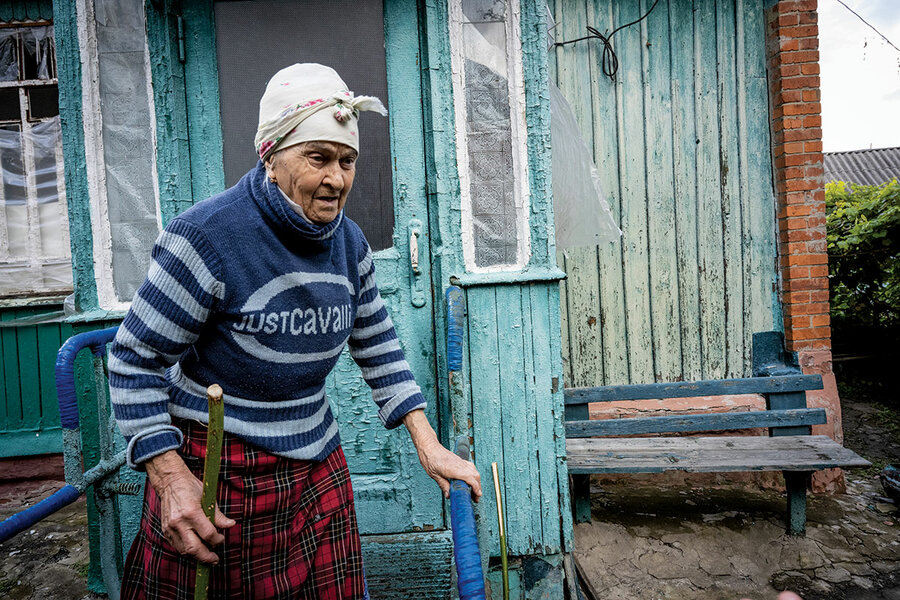
Ms. Tokar pointed to the rifle of my Ukrainian military escort and joked, “You should point it here,” motioning toward her head with a laugh, as if her decision to stay in the wrecked hamlet was crazy.
Winter was looming with frigid conditions, and Russia had been targeting electrical substations to keep Ukrainians cold.
Behind the house, Ms. Tokar’s 95-year-old aunt, Ksenia Yehorova, tended a fire to heat soup in a blackened pot and hacked pieces of wood from a rain-soaked woodpile.
I was impressed by their fortitude. Wrapped in multiple layers to ward off the cold, these women chose the manifest hardships of home over the uncertainties of someplace else.
“It’s very cold; we live like we are on the street,” Ms. Tokar said. “But my aunt doesn’t want to go.”
– Scott Peterson is the Monitor’s senior Middle East correspondent.
WE STARED AT THE STAIRS, not recognizing what they would mean to us for the rest of our lives. Rising from rubble through pockmarked concrete walls, they were glittery and crunchy with broken glass. We were reporting in Grozny, Chechnya, during a cease-fire in the brutal war between Russia and breakaway rebels in the summer of 1996. We’d been offered ostensibly safe quarters in a 10th-floor apartment of a bombed-out high-rise.
It was the first and only time my husband and I went on a reporting assignment together.
We’d had long days of physically tiring and emotionally difficult interviews – with rebel leaders, edgy Russian soldiers, and dazed Chechen civilians, one of whom offered up the apartment his family had abandoned.
It was a furnished room with a view and without water or electricity. Before heading upstairs, we each were handed a bucket of water – a humble offering of hospitality for drinking, washing, and aiding the toilet with gravity.
It’s hard to explain how the sad dust of war in that little apartment created the mortar for our sense of home.
We finally lay down to rest on a mattress on the floor, under a picture window with only a mean-looking 5-foot shard of glass intact. We watched the stars between bright-red rocket flares over the shell-shocked landscape.
But it was strangely comfortable.
We were us. Together, and unforgettably home.
– Clara Germani is a senior editor at the Monitor.
Family
IT’S AUGUST 2021, and we are on summer vacation in Fremont, California, known to us as Little Kabul, the largest Afghan community in the United States. My grandma Bibijan and I are sitting on an overstuffed couch looking at sepia-toned photos sprawled on the coffee table. With each image, I unlock a memory from the foggy corners of her 80-something-year-old brain.
In one picture, three women stand stiffly in the middle of an orchard. Bibijan smiles and recalls a stream and pomegranates, plucked fresh from the orchard. I listen intently – this is the closest I get to visiting what should have been my homeland.
My identity is scattered in pieces. Conceived amid the bombs in Kabul, I was born and raised until age 7 in Fremont, and taught that my mother tongue, Farsi, was a foreign language.
Then we moved to Istanbul, where I’m treated like a foreigner even though I have lived here so long. If I ever go to Afghanistan, they’ll see me as different, even though I look like them: brown and bold.
I am a bit of a cultural nomad, drifting across continents. Everywhere I go, I don’t belong.
But I feel at home every Saturday when I call Bibijan from Istanbul, and she can never get the camera to work on her iPad, and she repeats conversations because she forgets, and I hear the rhythms of her broken English. During these calls, it’s bearable that I don’t feel rooted in a place, because Bibijan’s love seems to reach across oceans and wrap around me like a hug. That’s how home should feel.
– Bonoo Azizian, an Afghan American writer living in Istanbul, is a sophomore in high school.
“OVER THE RIVER and through the wood, / To [grandmother’s] house we go.” That’s how a lot of kids, myself included, learned Lydia Maria Child’s 1844 Thanksgiving poem. It actually says “grandfather’s house,” but the popularized version made perfect sense to me since we literally drove over a river and through woods to get to my grandmothers, who lived about 30 minutes from each other.
Their houses were mirror images of each other. Whether I was at my maternal or paternal grandmother’s house, it was home. Everyone entered both places through the side door, because that brought you to the heart of the house. If the smells of the kitchen didn’t get your attention, the excitement from the living room would.
Their Southern drawls were different in tone but held the same warmth when they wailed, “Helloooooo!” It was a clarion call to love, to service.
To home.
I experienced that sense of security wherever they were. It could be in the reliable Ford my dad’s mom drove, where she let me pop in gospel cassette tapes, or in the grocery store my mom’s mom frequented. She was a strong woman with one weakness – the soft eyes of tiny, demanding grandchildren.
Grandmothers are guardian angels who disappear in a flash, leaving light and legacy. Without mine, it’s been hard to find my way back home. As it turned out, though, I didn’t have to go far.
My father’s house feels the most like home now. My children are on the floor, saturating the living room with toys, drawings, and juice. I look into their eyes and see both the past and the present. I am 40, yet I find myself getting lost in Dad’s brown corduroy couch as if I am 4. I’ve found what I was looking for.
– Ken Makin, who lives in South Carolina, is a contributing writer to the Monitor and host of the “Makin’ A Difference” podcast.
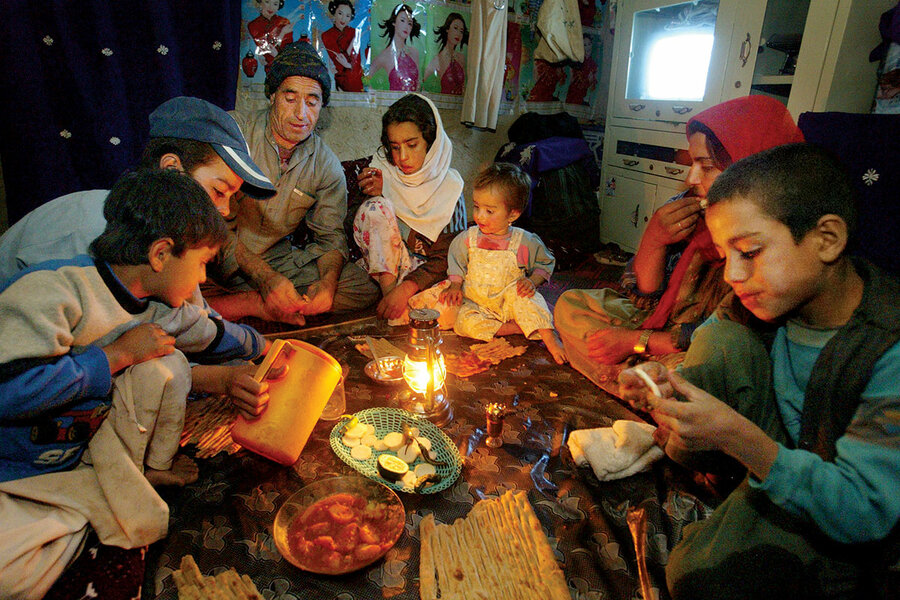
WHEN I WAS A CHILD, home was my grandmother’s house – white-washed, solid brick. What a gift to grow up with the security of a base to return to. How unknowingly lucky I was to have a roof over my head, everything I needed, nothing and no one left behind because of war, poverty, or disaster.
As an adult, I lived in various houses, apartments, and condos – all safe shelters.
Then I married and moved into my husband’s house, a ramshackle 1920s cottage he jokingly called a “hovel.” He told me we would renovate it together. Turned out, it was so ramshackle that we started over. Now I live in a house he designed just for us, with huge windows overlooking the tidal river it borders, wide windowsills for our kitties to lounge on, bookcases filled with his “friends” and my photos from distant lands.
But it’s not the walls and roof, the kitchen or bedrooms that make a house a home – it’s the people inside.
I have been invited into people’s homes all over the world – from an Afghan mud hut built into the ruins of a bombed-out building where the family was sharing an iftar meal during Ramadan, to a shack in Madagascar where the family had only one spoon and one bowl to share. I’m humbled each time a stranger opens their home to me. And I treasure the connection that happens between us in the intimacy of their private space.
I love to travel, but coming back to my husband is the best part. He is my home.
– Melanie Stetson Freeman is a staff photographer at the Monitor.

I DIDN’T KNOW how much I loved home until, at age 7, I went to an eight-week summer camp, nine hours away. Thinking about my mother, at home without me, sent me into paroxysms of tears – big, rolling sobs that welled up from someplace deep and uncharted. At night, I filled my Snoopy stationery with weepy pleas to bring me home.
Eight summers later, believing myself to be a self-possessed 15-year-old, I went on a cross-country teen tour. The first night, I learned that those homesickness spasms had burrowed deep into my muscle memory. The simplest discomfort of the trip would bring up convulsive, irrepressible tears. At age 15! The other kids gaped. My love for home had become a wrenching source of shame.

When I had my own children, I almost didn’t send them to camp so as to spare them this anguish. My heart cramped when the first tearful letter arrived from our 10-year-old son, scrawled by flashlight on his Minions stationery. But by then I understood that homesickness isn’t humiliation; it’s the low, low price of knowing deeply that you’re loved.
Homesickness is evidence of a love so primal it squeezes your heart and shreds your vanity. But that belonging is also the sensation we spend the rest of our lives chasing. “Home is heaven for beginners,” said late 19th-century American clergyman Charles Henry Parkhurst. Those of us lucky enough to have been homesick – or to have had kids who were – have snagged an early taste of heaven.
– Kinney Zalesne, a former Microsoft executive, is a strategy consultant in Washington, D.C.
Friends
HER EYES TWINKLE. “Shhhhh.” My childhood chum, now a high school junior, presses her forefinger against pursed lips. “Let’s have some fun.”
She balls her fist and bangs on a cupboard. “How do you open these?” She pounds once more, and this time the door swings open.
“Spring-loaded, eh?” She hops down from the counter and opens cupboard doors one by one, picking up speed as she goes.
“Let’s see what we got in here.” She pulls down jars and frowns. “Who eats this much spaghetti?” She crackles bags of pasta and giggles. “Plus, how come you didn’t know how to open these cupboards? This is your house, isn’t it?”
Indeed. But it is new to me and not yet a home. My parents moved us while I was away at camp. I’ve been here a week. I can’t recite my address.
My friend snaps me back to the present. “Ahhhh ... bingo.” She caresses a sleeve of chocolate-covered graham crackers and throws open the fridge. “Gotta have milk.”
She pops back up to her counter perch and sits – drink in one hand, sweets in the other. “You do the honors.” She thrusts the treats at me, but opens the milk and takes a swig.
Shouldn’t I get her a glass? She reads my mind and clamps my hand on the carton. “C’mon, christen your new house – time to make it your home.”
Throw caution to the wind, I say to myself. What’s a home without memories? I grab the drink and chug away. My pal laughs, her cheeks bulging. She snatches two more yummies from the plastic wrapper and jams them into her mouth.
“First one to the bottom wins.”
She beats me there, but I take the final prize – this house is now a home.
– Gloria Goodale is a former Monitor reporter who covered culture and politics from 1985 to 2016.
I WAS 11 YEARS OLD when I met Asya, and she seemed impossibly cool to me. She spoke fluent Russian, wrote poems, and wore sky-blue eye shadow. I was intense, shy, and gangly. We were sixth graders at a school for the arts, in the creative writing program, and somehow, we became best friends.
For the past decade, I have seen Asya at most once a year. She lives in the United States; I live in South Africa. But we speak nearly every day on WhatsApp, an endlessly unspooling thread of dog photos, bad-date stories, and “Queer Eye” memes. I wake up to selfies from her grandmother’s birthday. She gets a flurry of photos of the 3-foot-tall mini cows I saw on vacation as she spends her afternoon writing law briefs.

So much of my life has been documented and witnessed in our chat that opening it feels instantly like coming home. If this WhatsApp thread were a house, it would be the kind you enter without knocking, where you have free rein to rummage through the fridge or curl up with a book in the living room.
Recently, Asya and I spent a week in Georgia (the country, not the state). We hiked to ancient monasteries, pinched together fat dumplings in a cooking class, and went thrifting in a market hidden under a train station. When we were 11, Asya was the coolest person I knew. Now we are 34, and, impossibly, she still is: a tremendously funny, wise, and adventurous woman (though with less blue eyeshadow).
When the week was up, we parted ways in the airport to board our separate flights. Ten hours later, I landed in Johannesburg and turned on my phone. There was a text from Asya, asking about my trip. At once, I was home.
– Ryan Lenora Brown is a journalist and former Monitor correspondent in South Africa.
LAST YEAR, MY HUSBAND AND I sold most of our furniture, rented a U-Haul, and packed up our baby and two cats to move in with our friend and his dog. He had just bought a place, and we wanted to save up to buy our own home. We were adults in our 30s and 40s – what could possibly go wrong?
We entered the condo in a swirl of chaos. We discussed whether a microwave was necessary; we chose who had the best blender. We debated how many pictures could go on the walls and who got which bedroom.
Slowly, we transitioned to our new normal. We’ve learned each other’s rhythms and preferences. Our quirks have revealed themselves. The pets have made peace with one another, and we’ve settled into an unconventional calm.
One day, as my roommate struggled to find space for his groceries, I scurried over to move our things. I muttered an apology and shared that sometimes I felt like we’d ruined his ambiance, encroaching on him like a bunch of weeds.
I don’t feel that way at all, he said. To me, you guys are more like wildflowers, blooming everywhere.
I’ve realized that creating a home has nothing to do with owning one. It’s choosing to navigate your space with kindness, embracing everyone there and allowing them to embrace you.
It’s choosing to do life together, and leaning into everything that comes with it. Even the chaos.
– Samantha Laine Perfas is a contributing writer to the Monitor living in Revere, Massachusetts.
DURING THE PANDEMIC, I started cutting my husband’s hair. I had never done it before. I just decided to pretend I knew how to do it and then see what happened. The stakes were pretty low; no one was seeing anyone.
As I worked my way around his head of thick brown hair, I felt like a kid pretending to be a grown-up. And lo and behold, it wasn’t awful! He looked good, and my confidence grew. I started cutting my kids’ hair, and then my neighbors’ kids’ hair, and pretty soon, I was the go-to hairdresser in our co-housing community.
It was a total surprise and delight, and also a relief. I’ve lived in this community in Oakland, California, for a decade now, and it’s sad to realize that I have almost no practical skills. Randy can fix an ancient dishwasher, and Louise doesn’t bat an eyelash when she notices blight on the big peach tree. She knows exactly how to save it. Deborah can paint a mural, Jimmy can balance the books, and Nathan can get on the ladder and clean out the gutters without getting nervous at all. When the bees built a nest in Cheryl’s attic, Tom not only knew what to do but also was ecstatic – a new mother for his bee box! He put on his beekeeping suit and coaxed those little sweeties over to his part of the yard.
Meanwhile, I was wandering around asking people which weeds to pull and wishing my penchant for poetry was more useful. At least I make fat babies, I reasoned; everyone seems uplifted by those. But now I can cut hair! And while everyone loved me when I couldn’t, it feels good to have grown up at last.
– Courtney E. Martin is the author of “Learning in Public: Lessons for a Racially Divided America From My Daughter’s School.”

Nature
I HAD MOVED TO A CITY, which was very different from my home in the mountains. There were always cars on the road, and everywhere was paved and lit so brightly that the stars were hidden.
Many of the trees were ornamental – flowering beasts with spliced genes that made fruit so hard and sour the waxwings couldn’t eat it. In May, landscapers dropped fully blossomed tulips into the ground and then dug them up two weeks later, replacing them with geraniums.
I walked off-kilter without the rhythm of the natural cycles I’d grown up with: foamflower blossoming and then pink lady’s-slipper, wild strawberries ripening and then blackcap raspberries.
To help pay for groceries, I took a job babysitting two girls. We’d walk to a nearby park and shoot baskets and ride the slides. During a windy game of kickball in September, a wayward bounce and gust sent the ball toward a stormwater ditch.
On my retrieval, I found that, mercifully, no one had taken a mower to the edge or a weed wacker down into the muddy bottom. This gracious neglect meant that jewelweed, a native medicinal plant I recognized from back home, had endured, and its orange trumpet flowers were blaring beside the pregnant seed pods.
I showed the girls how to pinch the “ripe” pods to make the seeds spring forward. Then we waded through the patch and squealed at the unfurling between our forefingers and thumbs. Again and again, this simple joy from my own childhood, which is itself a home, was reflected on the girls’ grinning faces as they searched for the plumpest pods – each tiny burst sending them into a backstroke of happiness as their laughing took flight like pileated woodpeckers, cackling and colorful, into the sky.
– Noah Davis, a poet living in Montana, is the author of “Of This River” and has a second collection of poems coming out in 2025.
IF YOU DEFINE feeling at home as a sense of well-being, sometimes I am most at home when furthest removed from it.
The distance can be geographical, as when I was in a deserted park in New Mexico, miles from anyone, finding planets, stars, and deep sky objects in a staggering night sky. Or I can feel far away right there in the house where I live – when I’m watching a praying mantis on the outside of my living room window or lying in bed on a warm summer night, listening to the whinnying of a screech owl.
I can feel at home with my work and, of course, my family, but the greater sense of being at home has always come from nature – large and small, near and far.
Nature takes me out of myself, makes me look in wonder at the world, and pulls me away from the boorish and strident clamor of humanity. It makes me feel at home.
Except for mosquitoes.
– John Sichel is a music professor and composer who lives in New Jersey.

ON ASSIGNMENT in Taloyoak, Nunavut, in Arctic Canada, reporting a story about Inuit conservation efforts, I stayed in the home of a woman named Jeannie. It was June, the time of 24-hour sunlight, a time when light doesn’t dictate the patterns of work, meals, or sleep. Instead, the community maximizes being “out on the land.”
My first evening there, Jeannie had an event until 9 p.m. Afterward, she returned to the house, quickly showered, and then headed out on the land in an all-terrain vehicle to a simple camp two hours away to join her husband, grown children, and grandchildren for ice fishing. Watching her that first evening, I kept saying to myself, it’s 10 p.m. Why wouldn’t she sleep at home in her comfortable bed and then go out to her cabin first thing in the morning?
But the more I saw families heading into the tundra on their ATVs at 5 p.m., 8 p.m., I began to understand that being on the land for the Inuit is not a weekend passion. The land is their home.
For a culture that was seminomadic until the middle of the previous century, when they were forced into permanent settlement by the government, the ice lakes, Arctic shoreline, and tundra are home.
Jeannie motored away from her heated house, full refrigerator, and walls covered in photos of her grandchildren, I realized, because she, like all of us, just wanted to get home after a long day of work.
– Sara Miller Llana is the Americas bureau chief and deputy international news editor for the Monitor.

I HAVE A CONSPICUOUS, oversize tattoo of a hornet on the left side of my neck. I was stung when I was very young, and it became a core memory that shaped my reaction to basically any flying insect.
Friends would punk me at outdoor events, knowing I had a full-on phobia that extended even to honeybees and especially bumblebees. All it would take was a “bzzz” in my ear, and I’d be on the ground flopping and twisting and swatting at my neck amid a circle of laughter.
But last fall my wife, Petya, and I bought a house in upstate New York. Both of us had lived in New York City apartments for nearly 25 years. Now, suddenly, we and our three lifelong city dogs were living in a farm community.
It’s begun to change us.
On a bright spring morning this past May, I was jolted as I took the dogs out for a joyful, leashless run through our yard. The sound of buzzing was deafening, and it was right above me. My heart was pounding as I ducked and ran into the grass. For a second, I thought there must be a swarm of bees balled up on our porch posts.
Then Pet told me it was coming from our apple tree, which had just bloomed with burgundy-pink flowers, attracting thousands of honeybees.
I’m still trying to understand how what was once a sound of terror almost instantly transformed into one of awe.
Then, a few minutes later, as we sat on our porch behind two large rhododendron bushes, I saw dozens of bumblebees floating between the bright pink blooms. I marveled at their movements.
But mostly, I continue to marvel at how a 50-year phobia seems to have fallen away, as a defiant tattoo becomes a memory of things past.
– Harry Bruinius is a staff writer for the Monitor who splits his time between upstate New York and New York City.
Far away
“OH FUNNY, you still call Minnesota home,” the woman chortled. I’d just met her, a friend of a friend. We were sitting in my friend Mandy’s living room, surrounded by small plates of cut-up apples. Twelve different types in all. An impromptu apple tasting of the local French varieties.
“This reminds me of home,” I’d said.
I suppose it was absurd, coming from someone who’s lived in France for 15 years – a third of my life. Absurd from someone who, on numerous occasions and after a half-decade traveling around the world, has always said, “Home is where your stuff is.”
Technically, that’s true. But it’s also where the little memories reside – creeping onto a plate of apples, freshly cut and popping with all the flavors of a Minnesota autumn.
– Colette Davidson is the Monitor’s Paris correspondent.
SOME YEARS AGO, I moved to Rome from my home in the United States and was blissfully happy. Until Christmas, that is. I found myself deeply missing my family and friends, my familiar customs and traditions. I missed what I thought of as home.
For some reason, this homesickness crystallized around a family practice of gathering, every year, to listen to the actor Boris Karloff read Dr. Seuss’ book “How the Grinch Stole Christmas!” (This was not something readily available in Italy back then.) It became for me the symbol of all I felt I was missing.
One night, feeling particularly miserable, I dragged myself to the Wednesday testimony meeting at my local Christian Science church. Rome, of course, is full of beautiful churches. Ours was not one of them. Services were held in the basement of a YMCA. But as soon as I stepped into it, I was filled with the warmth of knowing that I was joining people in churches everywhere who were seeking their true home, which is in God.
After the meeting, I went to dinner with some people who were visiting Rome from my home country. I had never met them before, and I don’t remember how it came up, but I mentioned my love for “How the Grinch Stole Christmas!” To my amazement, one of them had a cassette of the same recording my family always listened to. She reached into her purse and gave it to me!

That night broadened and transformed my idea of home. It’s not a place but the knowledge of being loved and cared for – even in the small particulars. I’ve lived in many different locations since then, but I’ve learned that no matter where I am, I am always truly “at home.”
– Deborah Johnson, who lives in Columbus, Mississippi, is the author of “The Secret of Magic.”
I’D JUST CHECKED into a youth hostel in Kyoto, Japan, and I needed to get something to eat before it locked up for the night. My problem? I had an all-you-can-eat appetite, and $3 in yen. In the winter of 1979, that wouldn’t buy half an apple.
I wandered around the corner to an open-air market and found an older woman tempura-frying vegetables for people to take home. When I got to the front of the line, I handed her my money, all of it, with a shrug and a smile. In my travels, I’d acquired about 50 words of Japanese and no grammar. She looked at the money and fired off a minute of nonstop questions – in Japanese, of course. When she was finished, I shrugged again and said, in Japanese, “I’m sorry.”
She took a long look at me, came around the counter, took me by the shoulder, and led me to the back of her stall. She pulled an unopened can of cooking oil away from the wall and gestured for me to sit. I did. She took another can and placed it in front of me, covering it with a clean kitchen towel, talking the whole time. She went back to work, frying chunks of sweet potato, onion, eggplant, dried fish, and mushrooms. Every time she cooked an order, she’d make a little extra and bring it to me.
After the first plateful, I thanked her and stood up. She admonished me with a twinkling scowl and firmly sat me back down. She kept up her end of the conversation, and every time she’d look over her shoulder, or pause, I’d say, “Thank you. I’m sorry.”
It took an hour for her to decide I’d had enough. She shooed me off with a soft laugh. I’m not sure I’ve ever felt more at home.
– Chuck Wilcoxen lives in Maine with his wife, Hilary. Their nonprofit,Team Long Run, helps children learn to read and play freeze tag.
Lost and found
THE QUEEN BED in the attic glowed silver at 2 a.m., moon shards on the white metal frame. It had come out of a box, along with a heart-sinking collection of screws and hardware. I had cursed it under my breath as I wrenched it together some months earlier, but it ended up solid.
In the wee hours that night, it was a lifeboat. One daughter lay on my right, her little sister on my left, a tumble of heavy limbs and sleep. I listened to their breathing.
Our world had just changed. At the time I would have said shattered, but now I see it more like a snow globe. One shake, and I learned my marriage was over, finances were terrifying, my girls would have to switch schools, and – for some reason this kept hitting me hardest – we would need to move.
The house had never been ours. It was big and beautiful and came with my ex’s job. But we had decided, he and I, that we should treat it like home, for our family’s sake. So I had foolishly fallen in love.
Then, my girls and I moved into a rambling old rental a few towns away, another beautiful house that wasn’t ours. The three of us unpacked and cried and snuggled in the bed together again. Eventually, they began to see that place as home, but I knew better. When I was able, I bought my own house, smaller, simpler, in the woods. It was mine. I loved it. The girls decorated their bedrooms – pink and boho, light blue and elegant. The snow globe settled.

But “home” still felt elusive. We had moved so much, away from where I grew up, away from family, away from their childhoods.
Then, one night, they asked to sleep in my room again. They settled on either side of me. And as I watched the moonlight through my window, I realized home was right there.
It always had been.
– Stephanie Hanes is the Monitor’s environment and climate change writer.

Podcast
Covering the inventive Climate Generation
In the face of an unprecedented threat, one demographic group had the most to gain from action and the most to lose from complacency. That made it worthy of a multicontinent reporting project that spanned nearly a year. An editor and two writers take you inside the making of “The Climate Generation.”

If it’s Tuesday, this must be Namibia. No, wait, the Arctic. Or, maybe Bangladesh. Wardrobe considerations, alone, could be a story – one of many humorous and touching tales of reporters on the job that were implied, but rarely told, in a project like the Monitor’s series “The Climate Generation.”
Our writing team – environment correspondent Stephanie Hanes and Toronto bureau chief Sara Miller Llana – joined the Monitor’s “Why We Wrote This” podcast to talk about their global reporting odyssey. For most of 2023 – between packing bags and kissing their kids goodbye – they pulled at threads of connection and possibility among young people born since 1989. This generation is the first to grow up facing the reality of a changing, heating, disrupted environment.
Our findings are a window on the transformative nature of a warming world.
“We found this generation that was really growing up fundamentally differently than generations of the past. This reality of a heating, changing world is in the background of everything that they’re doing,” says Stephanie. “And this comes out in these really surprising and interesting – and I think we found really hopeful and exciting – ways.” – Clara Germani and Mackenzie Farkus
You can find story links and a transcript here.
The Young Hands on Earth’s Thermostat

Rekindling a friendship across continents
Even when geography, language, or customs differ, sometimes the strongest bonds transcend them, as our essayist discovers.
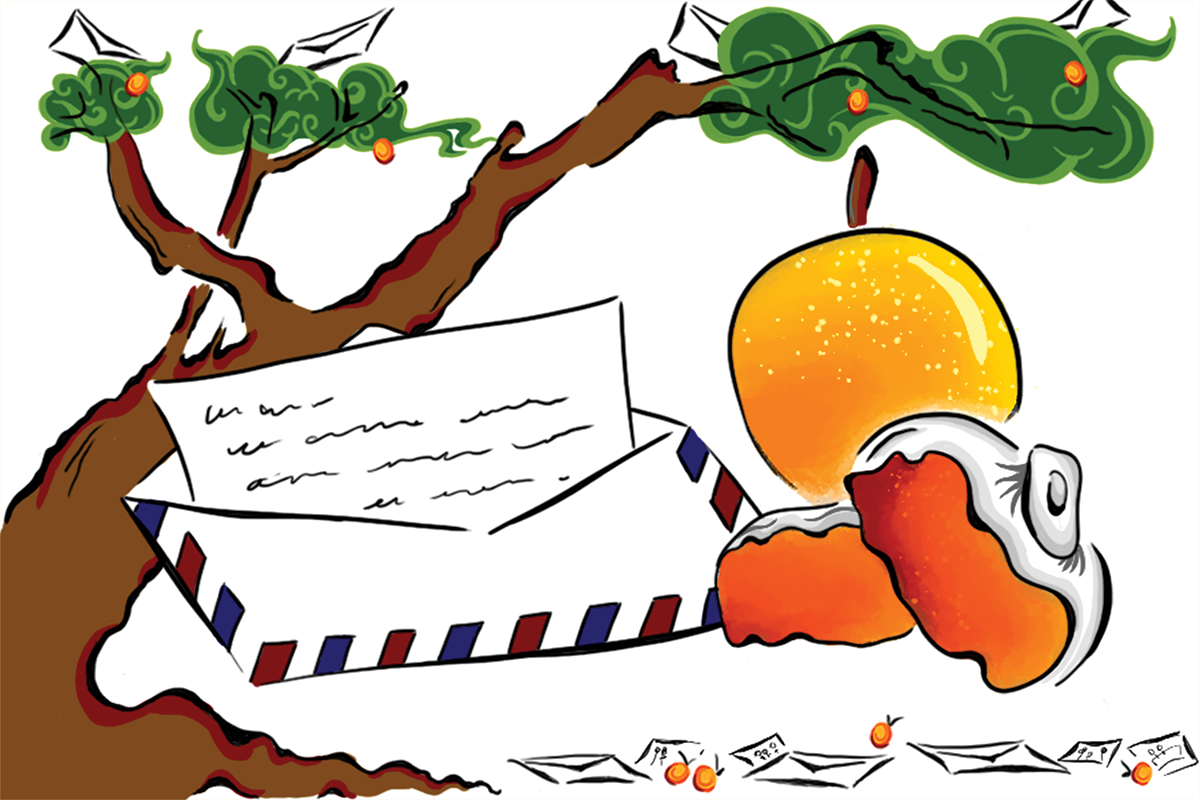
- Quick Read
- Deep Read ( 5 Min. )
-
By Megan Zhang Contributor
I exited baggage claim at Tokyo’s Haneda Airport and scanned the crowd for a face I hoped I’d recognize. I hadn’t seen the man in 23 years.
When I was growing up, my dad spoke of him endearingly, as “your Japanese uncle.” My dad was working as an interpreter in Beijing in 1991 when he first crossed paths with Shuichi Kosuge and the two became fast friends.
After my dad immigrated to Tennessee in 1993, Mr. Kosuge sent a holiday package – Japanese-made chocolates, warm gloves, a handbag for my mom. My parents returned the gesture, and with that, two distant families cemented an annual tradition. Even as we relocated every few years, receiving a package from Japan was one of the few enduring constants in our lives. Our Christmas observances were a quiet affair, but Mr. Kosuge’s special gifts injected the holiday with a sense of worldliness and revelry. He felt to me like a mysterious Japanese Santa Claus, introducing us to a world of delicately packaged rice-cracker snacks and thoughtfully chosen cashmere scarves.
I was eager to finally see him again, but as I waited, I began to feel nervous. What do you say to a stranger who isn’t really a stranger?
Rekindling a friendship across continents
I exited baggage claim at Tokyo’s Haneda Airport and scanned the crowd for a face I hoped I’d recognize. I hadn’t seen the man in 23 years, and my recollection of what he looked like came only from photographs – namely, the family pictures that came along with the holiday package he mailed from Japan every Christmas.
When I was growing up, my dad spoke to me of this man endearingly, as “your Japanese uncle.” My dad was working as an interpreter in Beijing in 1991 when he first crossed paths with Shuichi Kosuge, who was visiting the capital with a group of other Japanese lawyers. As my dad accompanied Mr. Kosuge’s delegation, the two became fast friends, bonding over a reciprocal curiosity about the other’s culture.
After my dad immigrated to Tennessee in 1993, Mr. Kosuge sent a holiday package – Japanese-made chocolates, gloves for cold Memphis winters, a handbag for my mom – to wish my parents a prosperous next chapter. My parents returned the gesture, and with that, two distant families cemented an annual tradition. Even as my parents and I relocated every few years throughout my upbringing – from Seattle, to Sacramento, and later to Hong Kong – the arrival of a package from Japan was one of the few enduring constants in our lives. Our little family’s Christmas observances were always a quiet affair, but Mr. Kosuge’s special gifts injected the holiday with a sense of worldliness and revelry. He felt to me like a mysterious Japanese Santa Claus, opening us up to a world of delicately packaged rice-cracker snacks and thoughtfully chosen cashmere scarves.
This summer, I traveled to Tokyo for some reporting. Before I went, I called my dad, who was in the middle of pruning the persimmon tree in my parents’ backyard in California, to let him know. He offered to write a letter to Mr. Kosuge, the only way they’ve ever corresponded, usually penning their messages in the recipient’s native language as a sign of respect. If he was in town and available, my dad suggested, perhaps I could pay Mr. Kosuge a visit. And if I had time between assignments, my dad added, maybe I could learn the Japanese art of making hoshigaki, or dried persimmons, while I was there. “Our tree always gives us more fruit than we know what to do with,” he said.
I was eager to finally see my dad’s friend again, but on the flight to Tokyo, I began to feel nervous. What do you say to a stranger who isn’t really a stranger?
I spotted Mr. Kosuge immediately. He stood at the front of the waiting crowd outside customs, holding a handwritten sign with my Chinese name. I approached him and waved; a look of recognition dawned on his face and then morphed into a wide grin. After an awkward pause, I said in Mandarin, “Long time no see!” He laughed at the understatement, eyes crinkling warmly behind his glasses.
On the train ride into the city, Mr. Kosuge reached into a modest tote bag he was carrying and pulled out a small photo album, which he handed to me. I opened it to see a picture of my dad, with more hair and fewer wrinkles, holding me as a preschooler. On the next page I was in my maroon middle school graduation gown, my parents flanking me. Then came my first high school flute recital, followed by my parents visiting the shimmering waters of China’s famed Jiuzhaigou National Park – their first solo vacation after I left the nest for college. Here were our most treasured memories and milestones, strung together with care by someone I barely knew.
My eyes began to feel warm as I realized that this album reminded me of another one, which my parents keep at their home in California. Every winter, my dad slides in Mr. and Mrs. Kosuge’s annual letter and photographs, mementos that chronicle the unfolding of our distant friends’ lives. All along, his family had been cherishing this long-remote friendship with as much care as my parents had valued theirs.
Later that evening, Mr. and Mrs. Kosuge took me to dinner at the sushi restaurant in my hotel. He told me that, after retiring, he spent five years living in China, teaching Japanese to Chinese teenagers. I asked if he’d studied Mandarin at university, but he shook his head. “I only started learning after that trip to Beijing when I met your dad. He deepened my curiosity about China,” he said. “None of that would have happened,” he added, “if it hadn’t been for your father.”
As we swapped stories, my Japanese uncle and I learned we are both enthusiastic home cooks. He told me he often makes Chinese food at home, especially the lighter, seafood-heavy fare of regions like Jiangnan, from which my dad hails. I thought about the Japanese ingredients and dishes, like natto and sukiyaki, that had been staples in our Chinese American household and wondered how much of that might have stemmed from their friendship.
Mr. Kosuge and I also discovered that we share a love for persimmons, a fruit enjoyed in both Japan and China. After leaving Tokyo, I traveled around the Kansai region, where persimmons flourish, to learn the art of making hoshigaki. Workers peel and hang the fruit to dry, and then periodically massage the drying persimmons to coax the natural sugars to the surface and eliminate air bubbles. The slow and labor-intensive, yet simple and rewarding, process produces a luxuriously plush, jammy texture in the dried fruit, with subtly sweet notes of caramel and cinnamon. It’s a labor of love that produces a gift of exquisite taste and precious time.
Before bidding the Kosuges farewell, I invited them to visit my family in California, where they can help themselves to the persimmon tree anytime. Until then, I’ll be practicing the art of hoshigaki with my parents’ bounty of fruit, and perhaps we’ll include some in our annual Christmas package to the Kosuges. My Japanese uncle has been sharing with us a taste of Japan for more than two decades, and it’s about time we returned the favor.
Other headline stories we’re watching
(Get live updates throughout the day.)The Monitor's View
Songs of beauty amid war
- Quick Read
- Deep Read ( 2 Min. )
-
By the Monitor's Editorial Board
The acoustics of warfare are as varied as the places where war is now being waged throughout the world – in deserts and forests, farmlands and city streets. Yet across these landscapes, there is one persistent and common sound.
Every day in Gaza, a small troupe of musicians moves from one makeshift camp of displaced people to another, gathering children within sheltering pockets of songs and poetry. “We use whatever means we can to remove the children from the war,” Ruaa Hassuna told Turkey’s Hürriyet Daily News. Her oud and voice, she says, drown out the hum of the drones overhead.
Similar stories emerge from wherever war is now being waged, from Ukraine to Sudan. They reflect a deep desire for a degree of dominion over conflict.
Through music, Russian artists have risked arrest to express anti-war themes of empathy and remorse. For Ukrainians, music has offered a way to push back against Russian President Vladimir Putin’s claim that they have no distinct cultural or national identity.
“Without music ... how are we then supposed to reconcile?” Fatoumata Diawara, a Malian musician, asked in an interview with Bloomberg earlier this year. Around the world, societies in war are writing songbooks of resilience, disarming hatred with chorales of innocence and peace.
Songs of beauty amid war
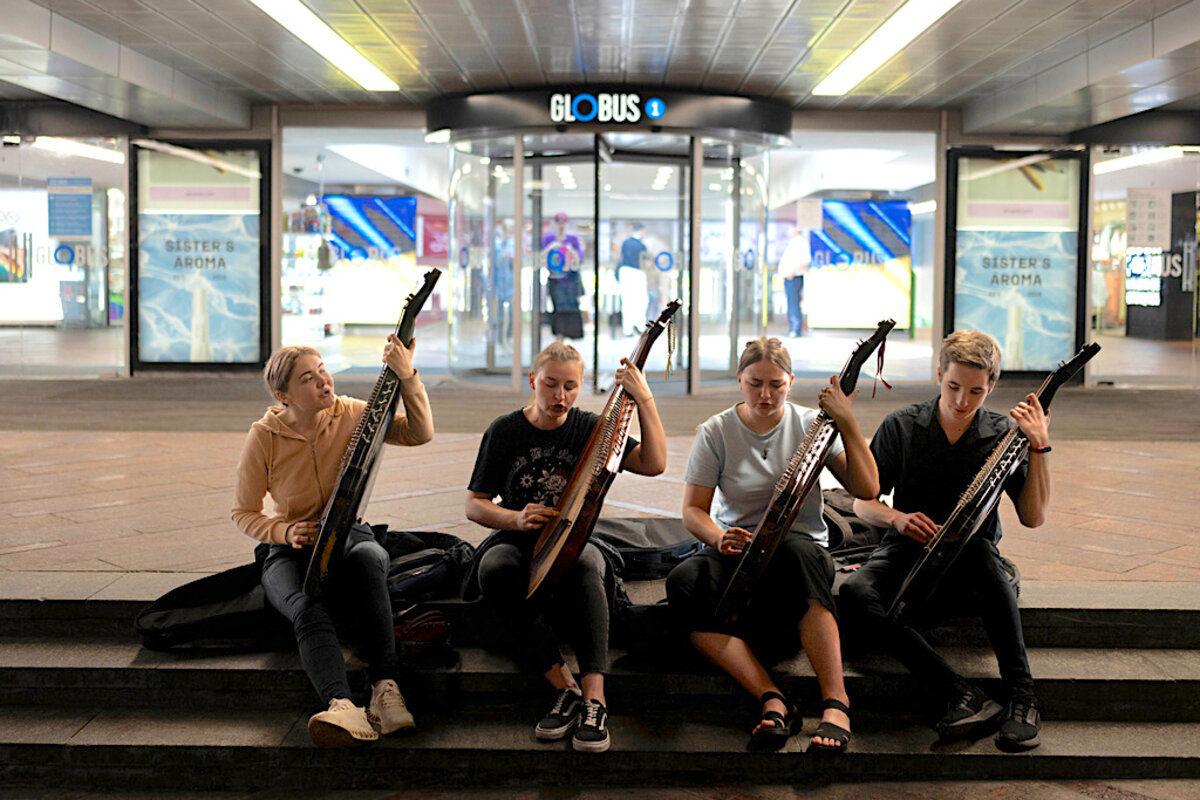
The acoustics of warfare are as varied as the places where war is now being waged throughout the world – in deserts and forests, farmlands and city streets. Yet across these landscapes, there is one persistent and common sound.
Every day in Gaza, a small troupe of musicians moves from one makeshift camp of displaced people to another, gathering children within sheltering pockets of songs and poetry. “We use whatever means we can to remove the children from the war,” Ruaa Hassuna told Turkey’s Hürriyet Daily News. Her oud and voice, she says, drowns out the hum of drones overhead.
Similar stories emerge from wherever war is now being waged, from Ukraine to Sudan. They reflect a deep desire for a degree of dominion over conflict and repression, a reclaiming of agency through beauty.
Through music, Russian artists have risked arrest to express anti-war themes of empathy and remorse. For Ukrainians, music has offered a way to push back against Russian President Vladimir Putin’s claim that they have no distinct cultural or national identity. In Kyiv, subway stations have become subterranean concert halls where musicians in tuxedos perform Ukrainian folk songs.
“Alongside the many indelible images from the war in Ukraine, there have also been some powerful stories with a musical theme,” writes Janine Natalya Clark, a professor of gender, transitional justice, and international law at the University of Birmingham in England. They show that music “can be viewed as a creative expression of resilience and, relatedly, resistance.”
Musicians in Sudan have responded to a fierce civil war with new songs of peace that capture the “unyielding hospitality” of Sudanese culture, as the local rapper Bas told NPR. In the storied city of Timbuktu in Mali, where Islamist extremists restrict the movement of people and goods through intimidation, residents set aside their fears recently to hold a festival. Merchants shared ideas to promote female entrepreneurship during the day. In the evening, musicians played.
“It’s needed more than ever, because it’s something to help lift people’s spirits and it brings a lot of support to the local economy,” Salaha Maiga, an organizer, told the BBC this week.
Perhaps the most powerful musical instrument rising above the din is the unaccompanied human voice. Women in Iran who had been imprisoned for political reasons recall Narges Mohammadi – the winner of this year’s Nobel Peace Prize – still protesting repression by singing Persian classical music deep within Tehran’s infamous Evin Prison. During the early months of the war in Ukraine, a solo voice hushed a crowded bomb shelter. Amelia Anisovych, a 7-year-old girl, sang “Let It Go” from the Disney film “Frozen.” A video of her performance traveled around the globe.
“Without music ... how are we then supposed to reconcile?” Fatoumata Diawara, a Malian musician, asked in an interview with Bloomberg. Around the world, societies in war are writing songbooks of resilience, disarming hatred with chorales of innocence and peace.

A Christian Science Perspective
Each weekday, the Monitor includes one clearly labeled religious article offering spiritual insight on contemporary issues, including the news. The publication – in its various forms – is produced for anyone who cares about the progress of the human endeavor around the world and seeks news reported with compassion, intelligence, and an essentially constructive lens. For many, that caring has religious roots. For many, it does not. The Monitor has always embraced both audiences. The Monitor is owned by a church – The First Church of Christ, Scientist, in Boston – whose founder was concerned with both the state of the world and the quality of available news.
The ceaseless activity of Christ
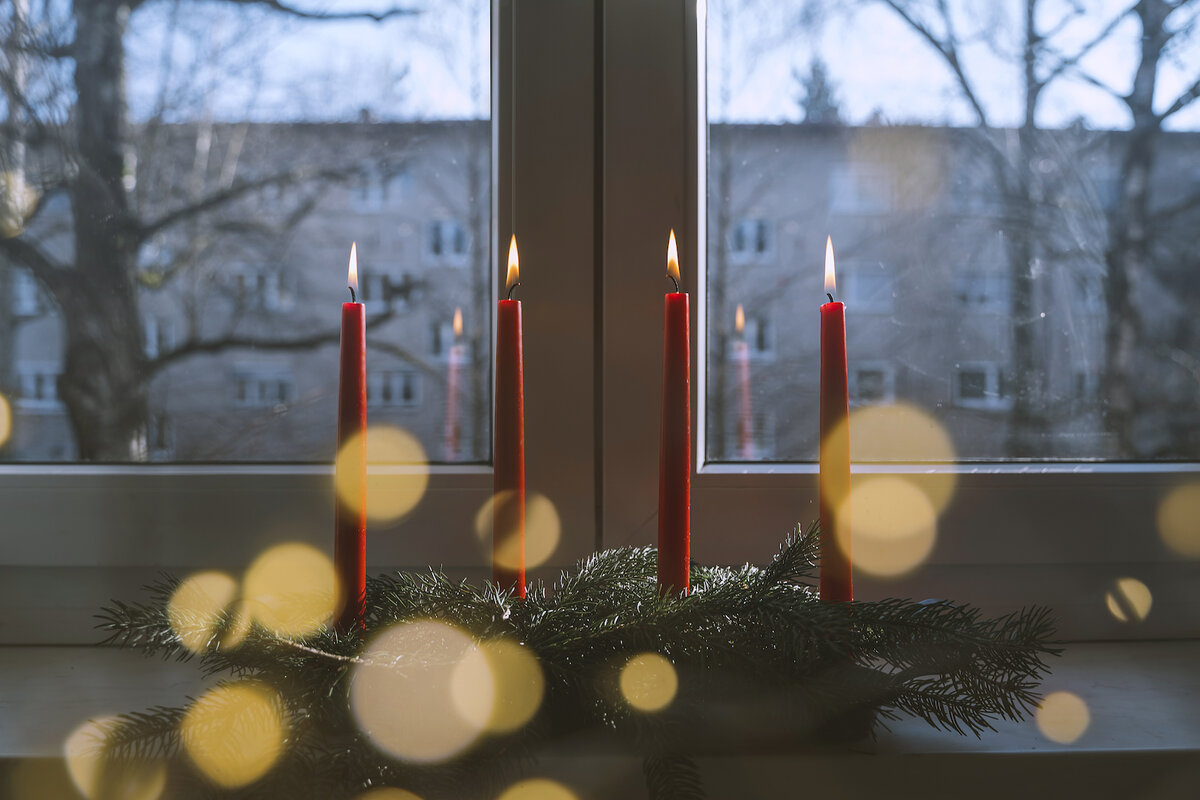
- Quick Read
- Read or Listen ( 1 Min. )
God’s saving message of the all-pervading nature of divine goodness came clearly through Jesus and remains with us forever.
The ceaseless activity of Christ
The grace of our Lord Jesus Christ be with you all.
– Romans 16:24
The advent of Jesus of Nazareth marked the first century of the Christian era, but the Christ is without beginning of years or end of days. Throughout all generations both before and after the Christian era, the Christ, as the spiritual idea, – the reflection of God, – has come with some measure of power and grace to all prepared to receive Christ, Truth.
– Mary Baker Eddy, “Science and Health with Key to the Scriptures,” p. 333
Christ comes, with succor speedy,
To those who suffer wrong;
To help the poor and needy,
And bid the weak be strong;
Christ comes to break oppression,
To set the captive free,
To take away transgression,
And rule in equity.
– James Montgomery, “Christian Science Hymnal: Hymns 430-603,” No. 458, adapt. © CSBD

Viewfinder
Star power

A look ahead
Thank you for joining us today, this week, and this year. We hope you enjoy our special projects next week and have a wonderful holiday season. We will continue keep our homepage updated with wire service content on any news events. The Christian Science Monitor Daily will return on Tuesday, Jan. 2.



